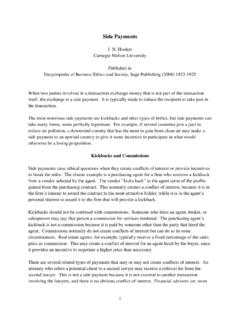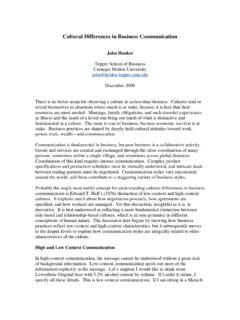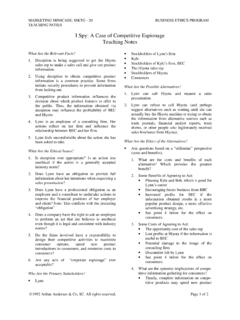Transcription of Cultural Differences in Business Communication
1 Cultural Differences in Business Communication John Hooker Tepper School of Business Carnegie Mellon University December 2008 There is no better arena for observing a culture in action than Business . Cultures tend to reveal themselves in situations where much is as stake, because it is here that their resources are most needed. Marriage, family obligations, and such stressful experiences as illness and the death of a loved one bring out much of what is distinctive and fundamental in a culture. The same is true of Business , because economic survival is at stake. Business practices are shaped by deeply-held Cultural attitudes toward work, power, trust, wealth and Communication . Communication is fundamental in Business , because Business is a collaborative activity. Goods and services are created and exchanged through the close coordination of many persons, sometimes within a single village, and sometimes across global distances.
2 Coordination of this kind requires intense Communication . Complex product specifications and production schedules must be mutually understood, and intricate deals between trading partners must be negotiated. Communication styles vary enormously around the world, and these contribute to a staggering variety of Business styles. Probably the single most useful concept for understanding Cultural Differences in Business Communication is Edward T. Hall s (1976) distinction of low-context and high-context cultures. It explains much about how negotiation proceeds, how agreements are specified, and how workers are managed. Yet this distinction, insightful as it is, is derivative. It is best understood as reflecting a more fundamental distinction between rule-based and relationship-based cultures, which is in turn grounded in different conceptions of human nature.
3 The discussion here begins by showing how Business practices reflect low-context and high-context characteristics, but it subsequently moves to the deeper levels to explore how Communication styles are integrally related to other characteristics of the culture. High and Low Context Communication In high-context Communication , the message cannot be understood without a great deal of background information. Low-context Communication spells out more of the information explicitly in the message. Let s suppose I would like to drink some L wenbr u Original beer with alcohol content by volume. If I order it online, I specify all these details. This is low-context Communication . If I am sitting in a Munich biergarten, it may be enough to say, Noch eins, bitte ( Another one, please ).
4 The waiter knows that I just drank a stein of L wenbr u Original, or that customers who speak with a foreign accent nearly always want the city s most famous beer. Because my remark is meaningful only in context, it is an example of high-context Communication . As a rule, cultures with western European roots rely more heavily on low-context Communication . These include Australia, Canada, New Zealand, and the United States, as well as much of Europe. The rest of the world tends toward high-context Communication . Naturally, high-context Communication can occur in a low-context culture, as the German biergarten illustrates. Communication within a family or close-knit group is high context in almost any part of the world. Conversely, low-context Communication is becoming more common in high-context cultures, due to Western influences and a desire to accommodate travelers and expatriates.
5 One of the more obvious markers of a low-context culture is the proliferation of signs and written instructions. If I step off the train in Munich, there are signs everywhere to direct me to the taxi stand, public transportation, ticket offices, tourist information, and lavatories. Detailed street maps of the area are mounted on the walls, and bus and tram schedules are posted. In much of the high-context world, there is little such information. Nonetheless everyone seems already to know where to go and what to do. Much of what one must know to operate is absorbed from the culture, as if by osmosis. In these parts of the world, my hosts normally send someone to meet me on the platform, partly as a gesture of hospitality, but also because they are accustomed to providing information through a social context rather than impersonal signs.
6 I am much less likely to be greeted in a German airport or station, not because Germans are inhospitable, but because they transmit information in a different way. It may appear that low-context Communication is simply an outgrowth of urbanization and international travel, rather than a Cultural trait. These are certainly factors, but there is an irreducible Cultural element as well. The smallest town in the United States carefully labels every street with a street sign and numbers the buildings consecutively, even though practically everyone in sight has lived there a lifetime and can name the occupants of every house. Yet very few streets in the huge city of Tokyo are labeled or even have names, and building numbers are nonexistent or arranged in random order. The United States and Japan are perhaps the world s most extreme cases of low-context and high-context cultures, respectively.
7 International travel and migration likewise fail to explain low-context and high-context behavior, even if they are factors. It is true that international airports are now well signed in most of the world. Yet there are few areas with a more transient and multicultural population than some of the Arab Gulf states, in which perhaps less than twenty percent of the population is indigenous. Communication nonetheless remains largely high context. Local authorities may post directional signs at roundabouts, in an effort to accommodate Western tourists and expatriates, but these are remarkably useless no doubt because the local people never rely on signs and therefore do not really know what it means to navigate by them. Regulating Behavior Low- and high-context Communication styles are, at root, contrasting approaches to regulating behavior.
8 One way to identify a low-context culture is that behavior norms are often communicated by putting them in writing them rather than through personal enforcement. If I am not supposed to enter a particular area or smoke there, posted signs will let me know. In a high-context culture, there may be no signs, but a guard or employee may accost me if I break any of the rules. I may take offense at this, because in a Western country , being called down for bad behavior implies that I should have known better, and I normally cannot know better unless someone writes down the rules. But in high-context cultures, being corrected by other persons is a normal procedure for regulating behavior. Whereas Westerners live in a world of rules and instructions and are lost without them, many others live in a social context.
9 A Western or international airport is full of signs and display screens that direct passengers to the correct check-in counter and gate, update departure times, and so forth. However, if I enter a crowded departure lounge in a regional, non-Western airport, I may find no signs or displays to indicate which gate corresponds to which destination, or if the displays exist, they may be blank or incorrect. Airline employees standing at the doorways may announce the flights, but they are inaudible in the din. Somehow, everyone knows where to go. They pick up cues from the people around them. For example, they may have unconsciously noticed who was in the queue with them when they checked in, and gravitated toward these same people when they reached the departure lounge. There are clear implications for Business Communication .
10 A manager in New York City transmits behavior norms through employee manuals and official memos. Employees who want a week off, for example, are expected to consult these sources, or perhaps their employment contracts, for whether they are entitled to a holiday. They follow prescribed procedures for filing a request, which is granted according to company policy. How employees make use of their holiday is of no consequence. In fact, managers typically want as little discretion as possible to evaluate the merits of the case, because they feel more comfortable applying rules than exercising personal judgment that they may have to defend. Employees in Bogot , by contrast, will more likely approach the boss, or a friend of the boss who can plead their case. They will explain how important it is to attend a niece s wedding in Miami or grandfather s funeral in Buenos Aires.





